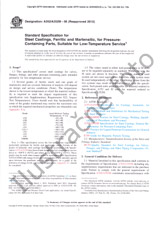Potrebujeme váš súhlas na využitie jednotlivých dát, aby sa vám okrem iného mohli ukazovať informácie týkajúce sa vašich záujmov. Súhlas udelíte kliknutím na tlačidlo „OK“.
ASTM F3211-17
Standard Guide for Fatigue-to-Fracture (FtF) Methodology for Cardiovascular Medical Devices
NORMA vydaná dňa 1.9.2017
Informácie o norme:
Označenie normy: ASTM F3211-17
Poznámka: NEPLATNÁ
Dátum vydania normy: 1.9.2017
Kód tovaru: NS-797263
Počet strán: 14
Približná hmotnosť: 42 g (0.09 libier)
Krajina: Americká technická norma
Kategória: Technické normy ASTM
Kategórie - podobné normy:
Anotácia textu normy ASTM F3211-17 :
Keywords:
ICS Number Code 11.040.40 (Implants for surgery, prosthetics and orthotics)
Doplňujúce informácie
| Significance and Use |
|
5.1 Use of this Methodology: 5.1.1 This guide provides a compendium of information on methods to use fracture data, fatigue life models, and statistical techniques to estimate the structural fatigue durability of an implantable medical device under anticipated 5.1.2 Through evaluation of fracture locations, the geometries after fractures, and the use conditions of the device, this guide may be used to help assess device safety. 5.1.3 This guide may be used to help assess differences in fatigue life between different devices or device histories. The effects on fatigue life due to changes to a device’s geometry, processing, or material may be assessed using this guide. 5.1.4 Users of this guide must keep in mind that bench tests are simulations of in-use conditions. Adherence to this guide may not guarantee that results translate to individual clinical scenarios. Therefore, in assessing a device’s fatigue performance, the results from Fatigue to Fracture testing should be reviewed in combination with other available data, such as animal studies, clinical experience, and computational simulations. 5.2 Significance of this Methodology: 5.2.1 While the FtF methodology applies only to bench tests, it can provide insights into device behavior that would not necessarily be apparent in clinical studies that typically focus on patient outcomes. After appropriate boundary conditions such as loadings, fixturing, and materials have been determined, the FtF methodology can provide extensive information on the expected longevity of a device in a period 10 to 1000 times shorter than a real-time clinical study. 5.2.2 FtF is informative in characterizing device behavior over a wide range of loads and cycles. This is especially valuable when the in vivo loading mode is understood but the load magnitude and cycle requirements are not well known or when characterizing device performance over a wide range of patient lifetimes, activity levels, and physiological states is desired. 5.2.3 In FtF, test loads greater than the devices’ expected use conditions are used. Thus, factors of safety can be measured relative to expected in vivo use conditions in both loading/deformation severity and number of cycles. 5.2.4 In FtF, the nature and location of fractures observed as a function of load can help provide insights into the device response to the applied loading. The identified primary and follow-on fracture locations and modes may be used to assess the credibility of device computational models, as well as to evaluate potential impacts on clinical safety and efficacy, especially post-fracture. 5.2.5 The FtF methodology can quickly and reliably assess the impact of changes in processes, materials, or small changes in geometry on in vitro fatigue life. These assessments with respect to fracture can be quantified and used as part of validating design changes, demonstrating that the device meets product specifications, or as part of guiding design improvements. 5.2.6 FtF testing can often be completed in a shorter period of time than test-to-success testing since the FtF tests are typically terminated at a smaller number of cycles. Specifically, when extrapolation in cycles is appropriate, comparisons of the loads or the frequency of fracture at a lower number of cycles can provide a useful measure of equivalence. |
| 1. Scope |
|
1.1 This guide is intended to provide an experimental methodology to assess and determine the structural fatigue life of implantable cardiovascular medical devices. 1.2 This guide is also intended to provide methodologies to determine statistical bounds on fatigue life at 1.3 This guide may be used to assess or characterize device durability during design development and for testing to device product specifications. 1.4 Fretting, wear, creep-fatigue, and absorbable materials are outside the scope of this guide, though elements of this guide may be applicable. 1.5 As a guide, this document provides direction but does not recommend a specific course of action. It is intended to increase the awareness of information and approaches. This guide is not a test method. This guide does not establish a standard practice to follow in all cases. 1.6 This guide is meant as a complement to other regulatory and device-specific guidance documents or standards and it does not supersede the recommendations or requirements of such documents. 1.7 This standard does not purport to address all of the safety concerns, if any, associated with its use. It is the responsibility of the user of this standard to establish appropriate safety, health and environmental practices and determine the applicability of regulatory limitations prior to use. 1.8 This international standard was developed in accordance with internationally recognized principles on standardization established in the Decision on Principles for the Development of International Standards, Guides and Recommendations issued by the World Trade Organization Technical Barriers to Trade (TBT) Committee. |
Odporúčame:
Aktualizácia technických noriem
Chcete mať istotu, že používate len platné technické normy?
Ponúkame Vám riešenie, ktoré Vám zaistí mesačný prehľad o aktuálnosti noriem, ktoré používate.
Chcete vedieť viac informácií ? Pozrite sa na túto stránku.




 Cookies
Cookies
